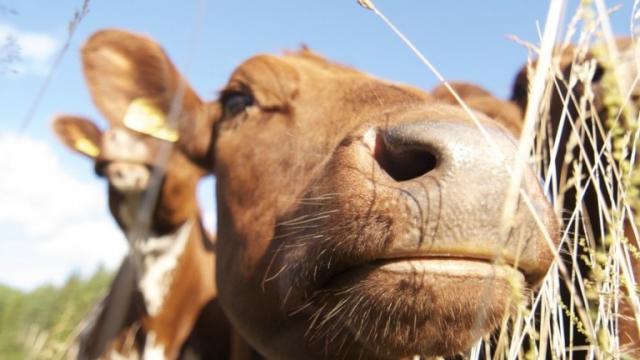
Mob management on a million acres in the Aussie Outback sounds like a tag line for a dark futuristic thriller from filmmaker George Miller. But a mob of 4,000 cows has been trampling and grazing across western Queensland in an environmental experiment that lets cows roam and graze in order to bring the carbon appetite of healthy soil back alive. The process takes carbon from the air and sequesters it in the soil, reducing atmospheric carbon loading in a very old-fashioned way: the migration of quadrupeds.
Mob management, or mob grazing as ranchers call it, and holistic management grazing as agronomists call it, is the brain child of Allan Savory. For 60 years Savory has championed a role that cows could be playing in a world mostly interested in hunting, milking and eating them.
In 2012, Savory gave a TED talk on how cows can help save the planet. For a talk about cows it went viral. Today, Savory’s theories are embraced as a relatively simple, low-cost and somewhat miraculous way to both regenerate soil and suck carbon down into it. The theories are also criticized as a crackpot’s defense of the wealthy eating more meat.
Savory's supporters include ranchers and farmers, nations and global pension funds worried about sustainability, and environmentalists. The very notion of managed cows moving lightly across the land brings to mind a bovine ballet. It's an endearing image.
The experiment in Queensland has the added impetus of a climate change truth: drought. Queensland has recently had a prolonged drought, says Tony Lovell of Sustainable Land Management Partners. SLM is a group funded by a Danish pension fund investing $75 million on a grazing plan rooted in Savory's healthy soil and moving cows concepts.
How it Works
The thousands of cows live and move along together every day as a herd. They munch, they shift around on hooves, they shit, they piss. There is massive disturbance of soil and plant life, eating going on around the clock, sleeping beneath the Australian stars. And as the mob moves along, herded by cowboys, drawn by fresher fodder, the disturbed soil left behind after 24 hours of intensive use is free to recover.
“Through disturbance,” explains Tony Lovell, “plants produce compensatory growth, new ecosystem niches are created, and the soil receives a mulching of organic matter. Extended rest allows highly palatable species, which are often overgrazed under a conventional stocking regime, to reoccupy the landscape.”
Sarah Cushing, an independent organic inspector in Vermont, simplifies holistic management grazing. “Soil is not this dead mineral thing," she declares. "There's a whole world down there. What we’re finding is this interaction of micro nutrients. In the past the soil never rested enough. It has to rest.”
In modern times, industrial farming has not let soil rest. One consequence has been a reduced ability to sequester carbon. In contrast, rested soil thrives. It regains organic volume. Organic soil sucks carbon from the air in proportion to its health, to its leafage and root volume. This kind of thinking is not new in Vermont or elsewhere, Cushing says. It’s part of a broader rethink of soil and “whole farming practices.”
There are workshops spreading the word on whole farm practices, Cushing tells me. On better ways to till and mulch, to harvest or leave fallow. There is a dynamic of soil and sky that new, smart agriculture is just discovering – or rediscovering, since the conditions were the norm before industrialized farming became the new norm.
"This is all a booming new field,” Cushing says, unable to restrain her excitement.
A young agronomist named Stanley Edwards in Utah tells me that he first heard of Allan Savory about 20 years ago. Edwards praises the new holistic grazing methods while stating a competing truth: “There is a struggle over grazing philosophies, how to maintain soil and organic matter.”
In the American west, he says, farming holistically with large grazing acreage “takes a philosophical and financial commitment. The public is not keen on seeing cows grazing on federal land. National parks and federal lands are run by the government and, as usual, government thinking lags behind the curve. Many regulations and perceptions oppose Savory’s vision. Not only because of the grazing, but because of the density of the animals where the public doesn’t expect them... but they would be moving all the time. The pasture has to rest.”
Cows Save Planet from Extinction
That kind of headline gets attention. It’s funny and serious, plausible and absurd. It's the title of a book, "Cows Save the Planet," by Judith Schwartz. The book is about soil rehab, about organic soil holding more water and sustaining itself by natural processes that chemicals and fertilizers have damaged.
Not everyone agrees about this, however. One attack of note on Savory's system and its logic came from the columnist George Monbiot in The Guardian. The title of Monbiot’s take-down was, “Eat more meat and save the world: the latest implausible farming miracle." Monbiot said, "I would love to believe him.” But he distrusted simple solutions to complex problems, and Savory's solution was exactly that. Give me more proof, Monbiot demanded, not unreasonably.
L. Hunter Lovins, co-founder of the Rocky Mountain Institute and a champion of natural capitalism, took on the challenge. She refuted Monbiot in The Guardian with a piece titled, “Why George Monbiot is wrong: grazing livestock can save the world,” and presented reasonable proof of Savory’s theories.
This tussle over cows and grazing and the underlying logic took place over a year ago. Since then Lovins's logic has prevailed and real-time examples grow in number. The pioneers of holistic grazing include three ranchers in Saskatchewan, North Dakota and Mississippi named Neil Dennis, Gabe Brown and Allen Williams, respectively. Articulate, photogenic and as natural as the scent of real manure, they star in Soil Carbon Cowboys, a short video dramatizing the new way to enrich soil, make more profit and help slow climate change.
This type of farming, the ranchers insist, reduces stress. It's good for dirt, plants and livestock. Results to date show that the three have regenerated the soil on their spreads in less than a decade. Summing it up, Gabe Brown, the rancher in North Dakota, says happily, "I think our whole world evolves around the carbon in the soil. It's the carbon molecules that feed soil life. And it's those micro-organisms that feed all the plants that nourish all the animals that feed civilization."
All in all, this is carbon-smart farming. It holds out exciting, promising prospects in a time of wrangling atmospheric scientists, geo-engineering conspiracy theories, and a lack of easily implemented plans of change – and it isn't heavily technological, expensive or unproven. Nothing out there about carbon sequestering feels as elevating and doable as sexy soil and happy cows.
Evidence of a kind of movement is gathering internationally. In addition to the Australian Outback, the soil cowboys in Canada and the U.S., and the Vermont and Utah operations mentioned here, nations are weighing in on soil sanity. The French Ministry of Agriculture, Agrifood and Forestry has launched a program to treat soil so that it sucks more carbon from the air and into the ground. They call it the Four Per Thousand Initiative.
According to the French, one the program is up and moving cows and improving soil, "a .4 percent annual growth rate of the soil carbon stock would make it possible to stop the present increase in atmospheric CO2."
That's quite a boost. Let's hope it's even half true.
There are, of course, snags and hurdles not given deep thought yet. In particular, land ownership issues. Fights over ownership of land are a festering wound globally. Native peoples and small farmers, in particular, are often on the losing side. And large-scale absentee owners allied with governments and banks on the wining one. How might holistic grazing avoid repeating that pattern?
Then there's sprawl, and the automotive way of life, burying productive soil on the outskirts of bloating cities on five continents. Such realities will forestall a rapid holistic grazing miracle of the scale the early adopters pitch and promote. The exit plan for the cows is not one that animal rights advocates will likely approve of either.
Yet the relatively simple shift to holistic grazing from the destructive industrial model that is now dominant has the duel engines of sanity and simplicity filling its sails. The result can be a vast, cheap carbon sink. And it brings along high-protein meat to feed a hungry world to boot.
3 WAYS TO SHOW YOUR SUPPORT
- Log in to post comments












